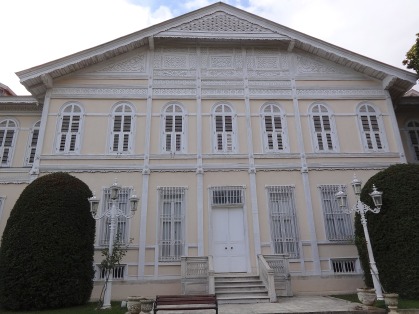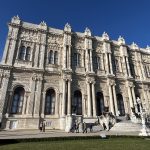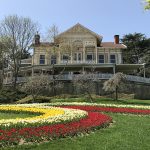Standing in a wonderful park above the Çırağan Palace Hotel, Yıldız Sarayı in Beşiktaş is the least known of İstanbul’s imperial palaces which receives far fewer visitors than it deserves. Poised on a wooded hillside, the park makes a glorious escape from the roar of the traffic, a place where you could almost forget that you’re even in the city as you settle down to lunch beside the pool in front of the Cadır Köşkü or take a turn around the lovely marble fountain inside the Malta Köşkü.
Here you can also inspect the imperial porcelain factory, the neglected City and Yıldız museums, and the Şale with its impressive dining room set up as if Sultan Abdülhamid II might be arriving to eat at any moment. 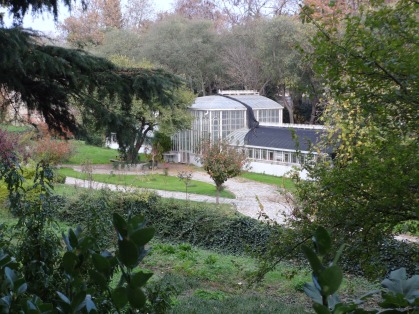
Quick note for sensitive souls. Yıldız Park does have a a bit of a Lovers’ Lane reputation. Beware shady corners!
Yıldız Palace
The palace complex at Yıldız began life during the reign of Selim III (r. 1789-1807) when the sultan had a park laid out here for his mother, Mihrişah Sultan. However, it didn’t really come into its own until the reign of Sultan Abdülhamid II (1876-1909).
In 1878 an attack on the waterside Çırağan Palace highlighted a potential weakness in security at the nearby Dolmabahçe Palace. Frightened by the fate of his uncle, Sultan Abdülaziz, the nervous Abdülhamid opted to retreat inland for what he believed to be the greater protection of Yıldız.
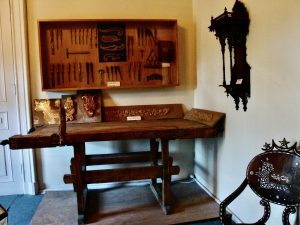
Once moved in, Abdülhamid occupied the State Apartments built by Selim III which are not currently open to the public. Instead, you can visit the Yıldız Şale (chalet), a completely separate guesthouse dating back to the 1870s. When Kaiser Wilhelm II of Germany paid a visit to İstanbul in 1889, the sultan had the small existing guesthouse expanded especially to accommodate him. Expanded again in 1898 when the Kaiser visited for the second time, it ended up as a suite of 60 rooms lurking behind a deceptively simple façade, rather fancifully described as resembling a Swiss chalet.
What is more surprising about the building is that it somehow manages to look cohesive despite having been built in three different stages and under the supervision of architects with such different visions as the baroque supremo, Sarkis Balyan, and the Art Nouveau genius, Raimondo d’Aronco.
Inside, the Şale is predictably extravagant, the over-the-top decoration culminating in a magnificent dining room still set up as if the Kaiser might walk through the door anticipating a banquet. Almost equally impressive is the huge Ceremonial Hall, where guests used to be received. This is home to the largest Hereke carpet ever woven, covering an impressive 400 square metres of floor.
Unfortunately, Yıldız is not a particularly visitor-friendly site. Unlike Dolmabahçe but like the much-older Topkapı, the palace consists of a collection of buildings, in this case separated from each other by a wall through which visitors cannot pass, the separation serving as physical testimony to the sultan’s paranoia.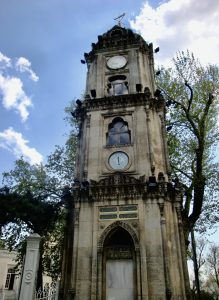
On one side of the wall, you’ll find the State Apartments rubbing shoulders with the Yıldız Sarayı Müzesi (Yıldız Palace Museum) and the Şehir Müzesi (City Museum). On the other side of the wall, the Şale presides over a landscaped garden at the top of Yıldız Parkı which is also home to the Çadır and Malta Köşks. These lovely pavilions now serve as small café-restaurants. The Malta in particular is a delight, with the small marble pool on the ground floor looking much like the larger model that graces the interior of Beylerbeyi Palace.
Also inside the park is the Raimondo d’Aronco-designed Imperial Porcelain Factory, where from 1896, replicas of Sèvres porcelain were turned out to reduce the palace bill for importing the real thing.
Yıldız came to an unhappy end in 1909 when Abdülhamid was deposed and the palace ransacked. For the rest of the 20th century its future looked uncertain. For some years, the Şale served as a casino, but eventually most of the buildings were abandoned. In the 1980s, they were restored by Çelik Gülersoy‘s Touring and Automobile Club of Turkey before being returned to the state and opened to the public. Even today, though, there are many İstanbul residents who have never visited Yıldız.
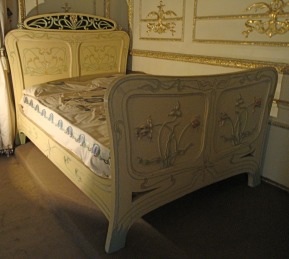
Yıldız Palace and City Museum
Between them these two small museums (closed Mondays) house a fine collection of paintings, Art Nouveau bric-a-brac and wooden furniture made by Sultan Abdülhamid, an enthusiastic carpenter. You’ll be unlucky if you have to share them with a single other visitor.
The Yıldız Palace Museum leads through into the Kücük Mabeyn where a few rooms once used by Sultans Abdülhamid and Mehmet VI, and Atatürk are now visitable. Their decor is more restrained than that in some of the other 19th-century palaces which will suit those who find Dolmahabçe a little overblown.
Dark histories They may be delightful cafes now but both the Malta and the Çadır Kösks hide grim pasts. The Malta Köskü served as prison for Sultan Murad V after he was overthrown in 1856 while the powerful grand vizier Mithad Paşa was tortured in the Çadır Köşkü after being implicated in the possible murder of Sultan Abdülaziz in 1876.
Hamidiye Cami
If you approach the palace complex from Barbaros Bulvarı in Beşiktaş you will first come to a colourful mosque that was built just outside the entrance to the State Apartments in 1886 after an assassination attempt at Friday prayers persuaded Sultan Abdülhamid that he must worship in greater privacy. He worked on the woodwork for the mimber himself.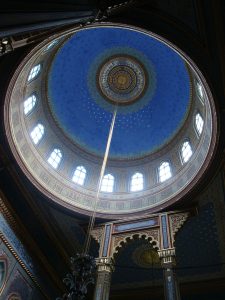
In front of the entrance to the mosque is a three-storey clocktower erected in 1890.
Küçük Mecidiye Cami
If you approach the palace complex from the coast road you will first pass the small mosque built in 1848 for Sultan Abdülmecid using soil from Mecca in the walls. The original medrese, caravanserai and sibyan mektep (primary school) that once formed a complex with the mosque have long since been demolished.
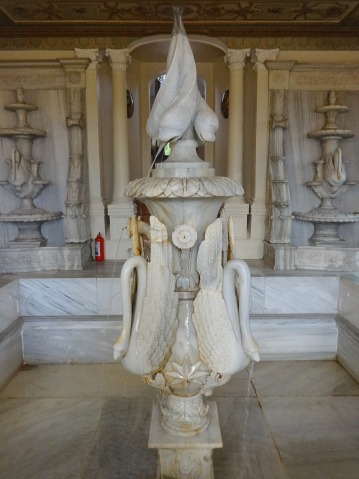 Interior of Malta Köşkü
Interior of Malta Köşkü